Climbing into the front seat of a Harvard for the first time is quite some feeling. Immediately, that intoxicating old-aeroplane smell hits you; AVGAS and oil and metal and leather transporting you back to WW2, when the Harvard was the primary trainer for most of the incredibly brave and pioneering pilots who came before us. This sensory time-travelling continues from the moment the starter spins up, and the 9-cylinder, Pratt and Whitney R-1340 radial engine first splutters to life, sending out puffs of smoke onto the apron. The prop comes from fully coarse to fully fine, when the engine has warmed the oil sufficiently, and the note of the engine rises, the vibration in the cockpit decreasing.
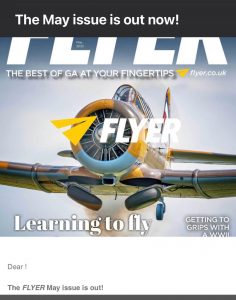 “Great start,” shouts Andy, standing on the wing of his aircraft, the “Wacky Wabbit”, and watching, eagle-eyed, as I have my first go at starting this incredible and slightly intimidating machine, “Now, stick the radios on, bring it up to 1000 rpm, and I’ll jump in the back seat.” Off he goes and I’m left in the front, watching the temperature gauges and peering out through the windscreen, trying to commit the position of the nose in this attitude to memory; it will be important later, when trying my first three-point landing. While there is no immediate reference point on the aircraft that neatly aligns with the horizon, a semi-circle of cowling peeps above it, and I will have to try and replicate that same picture in the flare, just before touching down.
“Great start,” shouts Andy, standing on the wing of his aircraft, the “Wacky Wabbit”, and watching, eagle-eyed, as I have my first go at starting this incredible and slightly intimidating machine, “Now, stick the radios on, bring it up to 1000 rpm, and I’ll jump in the back seat.” Off he goes and I’m left in the front, watching the temperature gauges and peering out through the windscreen, trying to commit the position of the nose in this attitude to memory; it will be important later, when trying my first three-point landing. While there is no immediate reference point on the aircraft that neatly aligns with the horizon, a semi-circle of cowling peeps above it, and I will have to try and replicate that same picture in the flare, just before touching down.
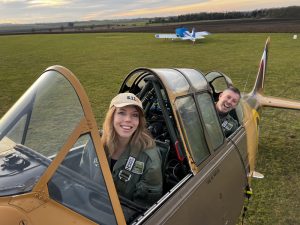 Andy has strapped in now behind me and it’s time for taxi practise. I make the call to Fowlmere radio, release the brakes, open the throttle, and feel the Wabbit start to creep forward along the grass. We are facing into wind so I make sure the stick is fully back, forcing the wind and the slipstream from the propeller over the elevator and sticking the tail to the ground. Taxiing the Harvard is fairly straightforward, once you’ve mastered the art of locking and unlocking the tailwheel, as there is a fairly delicate pin mechanism which allows it to free-caster when the pin is removed. If it’s left out, or if it shears, it can be catastrophic news on take-off or landing; something which been the cause of multiple accidents in Harvards.
Andy has strapped in now behind me and it’s time for taxi practise. I make the call to Fowlmere radio, release the brakes, open the throttle, and feel the Wabbit start to creep forward along the grass. We are facing into wind so I make sure the stick is fully back, forcing the wind and the slipstream from the propeller over the elevator and sticking the tail to the ground. Taxiing the Harvard is fairly straightforward, once you’ve mastered the art of locking and unlocking the tailwheel, as there is a fairly delicate pin mechanism which allows it to free-caster when the pin is removed. If it’s left out, or if it shears, it can be catastrophic news on take-off or landing; something which been the cause of multiple accidents in Harvards.
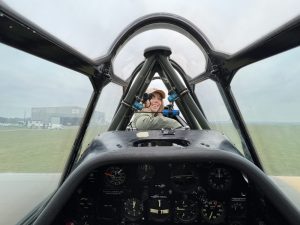 Eventually Andy is happy with my ground handling and, to my absolute delight and excitement, it’s time for power checks and then take-off. Fowlmere was a base for Spitfires in the war playing host to legendary pilots such as Sandy Lane and “Grumpy” Unwin (and his dog Flash) and, S-turning my way to runway 25, I can’t help wondering how those men must have felt as they taxied out not for a flying lesson, but to take part in daring missions from which there was always a chance they may not return – an incredibly humbling thought.
Eventually Andy is happy with my ground handling and, to my absolute delight and excitement, it’s time for power checks and then take-off. Fowlmere was a base for Spitfires in the war playing host to legendary pilots such as Sandy Lane and “Grumpy” Unwin (and his dog Flash) and, S-turning my way to runway 25, I can’t help wondering how those men must have felt as they taxied out not for a flying lesson, but to take part in daring missions from which there was always a chance they may not return – an incredibly humbling thought.
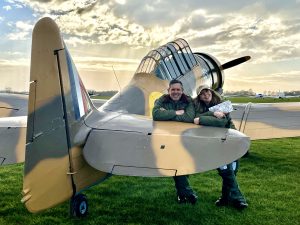 We line up and I apply power, very smoothly, to prevent excessive yaw to the left and to take care of the engine. The takeoff roll is unlike anything I have ever experienced. The noise-cancelling in my headphones does little to disguise the roar of the engine as it reaches takeoff power, accelerating us rapidly over the grass. The torque effects are immediately obvious as we reach take-off power, with a good amount of right rudder having to be applied, increasing as I push the stick forward to a low-tail, shallow climb attitude. I keep the nose straight, trying not to deviate more than 5 degrees and, before I know it, we are airborne.
We line up and I apply power, very smoothly, to prevent excessive yaw to the left and to take care of the engine. The takeoff roll is unlike anything I have ever experienced. The noise-cancelling in my headphones does little to disguise the roar of the engine as it reaches takeoff power, accelerating us rapidly over the grass. The torque effects are immediately obvious as we reach take-off power, with a good amount of right rudder having to be applied, increasing as I push the stick forward to a low-tail, shallow climb attitude. I keep the nose straight, trying not to deviate more than 5 degrees and, before I know it, we are airborne.
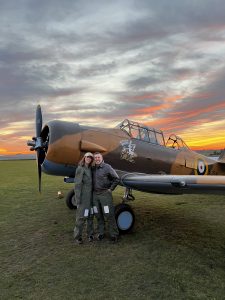 Gear up; throttle back to 30 inches manifold pressure; prop back to 1950 RPM. We take a left turn out of Fowlmere, the aircraft climbing faster than any single engine piston I’ve been in before. We level off eventually at about 2000 ft, heading out to the North for some general handling. We settle her down at 23 inches and 1850 rpm, and practise balanced turns, which I find to be surprisingly tricky at first. Next it’s steep turns and stalling: I try my hand at clean stalls and stalls with one stage of flaps, while Andy says he is going to to demonstrate a final configuration stall. My experience was that the Wabbit stalls fairly nicely while clean, but can tend to drop a wing easily. The final configuration stall, however, was something else. The aircraft rolled and pitched down dramatically, airspeed increasing rapidly. The trick to this stall is to try not to overspeed the drag flap. Flap operation from fully extended to 20 degrees requires two inputs, which is difficult to do while trying to maintain control of the airframe. One that’s away, the gear and then the final stage of flaps can come up, once a positive rate of climb has been achieved. All of these stalls, although sometimes more vicious than I am used to in other aircraft, will be fairly familiar territory to most pilots.
Gear up; throttle back to 30 inches manifold pressure; prop back to 1950 RPM. We take a left turn out of Fowlmere, the aircraft climbing faster than any single engine piston I’ve been in before. We level off eventually at about 2000 ft, heading out to the North for some general handling. We settle her down at 23 inches and 1850 rpm, and practise balanced turns, which I find to be surprisingly tricky at first. Next it’s steep turns and stalling: I try my hand at clean stalls and stalls with one stage of flaps, while Andy says he is going to to demonstrate a final configuration stall. My experience was that the Wabbit stalls fairly nicely while clean, but can tend to drop a wing easily. The final configuration stall, however, was something else. The aircraft rolled and pitched down dramatically, airspeed increasing rapidly. The trick to this stall is to try not to overspeed the drag flap. Flap operation from fully extended to 20 degrees requires two inputs, which is difficult to do while trying to maintain control of the airframe. One that’s away, the gear and then the final stage of flaps can come up, once a positive rate of climb has been achieved. All of these stalls, although sometimes more vicious than I am used to in other aircraft, will be fairly familiar territory to most pilots.
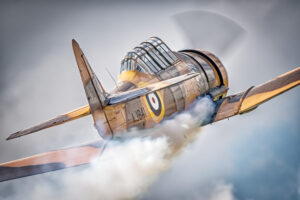 However, when Andy takes control from the back and demonstrates an accelerated stall, turning to the left and applying too much back pressure on the control stick, the aircraft snaps violently into a sudden roll and pitch down to the right. I’m taken aback by the ferocity, which is a rude awakening to the dangers of being in too much of a hurry to tighten one’s turns. Accelerated stalls have been the cause of numerous fatalities over the years; both while manoeuvring in-flight and, most perilously, at low level on a base-to-final turn.
However, when Andy takes control from the back and demonstrates an accelerated stall, turning to the left and applying too much back pressure on the control stick, the aircraft snaps violently into a sudden roll and pitch down to the right. I’m taken aback by the ferocity, which is a rude awakening to the dangers of being in too much of a hurry to tighten one’s turns. Accelerated stalls have been the cause of numerous fatalities over the years; both while manoeuvring in-flight and, most perilously, at low level on a base-to-final turn.
General handling over, it’s time to head to Duxford for circuits. Andy is going to demonstrate the first three-pointer, and then it’ll be my turn. I learned to fly at an integrated school on DA-40s: simple, nose-wheel aircraft with an engine control unit, so the journey to flying older, tailwheel aircraft has been full of learning curves. With the Harvard, there’s a lot to think about; alongside management of the pitch of the propeller and the carburettor heat, it’s important to remember that the systems on the aircraft are over 70 years old, hence it being absolutely imperative to monitor everything carefully. There are four signs to check that the gear is actually down: Hydraulic pressure reading, two green lights illuminated above two white position indicator pegs (which should be at the bottom of their range of travel), and being able to see two yellow strips through the small windows located on the top of each of the wings. Failure to check all of these could result in a gear-up landing and a hefty bill to pay, at best!
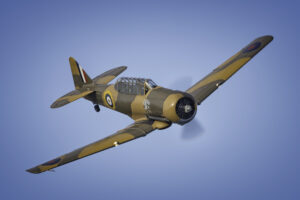 The wind is mercifully calm, with only a trickle straight down the runway. Downwind, I perform my standard checks, configure the aircraft with gear and 20 degrees of flap, pop the carburettor heat on, and put the prop fully forward (delaying this until base leg for noise abatement reasons). Andy tells me to make the turn to base leg at no less than 100 mph, and to make the final approach at between 85-90 mph, as the speed will bleed off rapidly in the flare due to the weight and drag of the airframe. I hand the Wabbit to Andy on final, after putting in full flap and knocking off the carburettor heat, and follow through his control inputs.
The wind is mercifully calm, with only a trickle straight down the runway. Downwind, I perform my standard checks, configure the aircraft with gear and 20 degrees of flap, pop the carburettor heat on, and put the prop fully forward (delaying this until base leg for noise abatement reasons). Andy tells me to make the turn to base leg at no less than 100 mph, and to make the final approach at between 85-90 mph, as the speed will bleed off rapidly in the flare due to the weight and drag of the airframe. I hand the Wabbit to Andy on final, after putting in full flap and knocking off the carburettor heat, and follow through his control inputs.
At about 30 feet from the ground, he breaks the glide, beginning to pitch the nose steadily upwards and retarding the throttle. As the ground rises to meet us the flare continues, the power now at idle. My eyes are fixed at the end of the runway, and I can see that same semi-circle of cowling beginning to creep like the sun over the horizon. When it reaches the same point as I had clocked on the ground, I feel the wheels touch. My hand is pulled towards my abdomen as the dual-controlled stick aerodynamically glues the tail to the ground. The grass at Duxford is bumpy in places, and my feet dance along on the pedals as Andy makes his rapid rudder inputs. He is keeping it within five degrees of runway heading at all times, feeling and anticipating any wandering of the nose, compensating for it intuitively. We slow down eventually to the point where brakes can be slowly applied, and backtrack the runway. It was a beautiful landing – especially considering it had been performed from the back where I can confirm, from experience, that forward visibility is pretty much negligible.
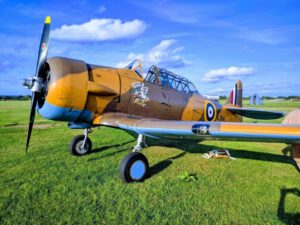 While we backtrack we discuss Andy’s landing: What I saw and felt, and how I’ll replicate it next time, when it’s my turn to try a three pointer. As we turn around to line up on runway 24 we have a small delay so I take the opportunity to gaze out at the other historic aircraft on the apron at Duxford. To follow in the slipstream of the men and women who flew these machines, in extraordinary circumstances and at a time when they were completely groundbreaking, is a real privilege. It’s a brief, poignant moment of feeling deeply connected to and entangled with the past, and it’s only the controller’s voice crackling through my headset that brings me back to the here-and-now, where I realise it’s time to now channel their determination and nerve to try to safely execute my first full circuit and landing.
While we backtrack we discuss Andy’s landing: What I saw and felt, and how I’ll replicate it next time, when it’s my turn to try a three pointer. As we turn around to line up on runway 24 we have a small delay so I take the opportunity to gaze out at the other historic aircraft on the apron at Duxford. To follow in the slipstream of the men and women who flew these machines, in extraordinary circumstances and at a time when they were completely groundbreaking, is a real privilege. It’s a brief, poignant moment of feeling deeply connected to and entangled with the past, and it’s only the controller’s voice crackling through my headset that brings me back to the here-and-now, where I realise it’s time to now channel their determination and nerve to try to safely execute my first full circuit and landing.
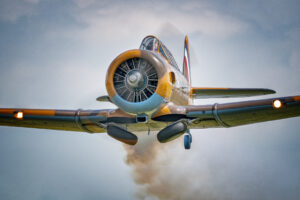 The take off goes well, as does the circuit. I hold 90 mph on final and, as we approach the threshold, I begin pulling the power back and flare, aiming for a gradual and smooth rotation. However, before I’ve quite managed to set the landing attitude, the mains touch and we make a small skip across the ground. As earlier briefed, when discussing corrective action, I assess the severity of the skip and the attitude – deciding to hold it for a moment before resetting to the three-point picture. This allows the aircraft to settle so I pull back the stick fully, stare straight ahead, and try not to let the nose move too far either side of centreline. On a couple of occasions I can feel the amount of pressure on the rudder pedals needed to maintain the line increase, really allowing me feel how heavy the back end of the Harvard actually is, and how vital it is to prevent it creating too much of a moment – We’d be ground looping in no time!
The take off goes well, as does the circuit. I hold 90 mph on final and, as we approach the threshold, I begin pulling the power back and flare, aiming for a gradual and smooth rotation. However, before I’ve quite managed to set the landing attitude, the mains touch and we make a small skip across the ground. As earlier briefed, when discussing corrective action, I assess the severity of the skip and the attitude – deciding to hold it for a moment before resetting to the three-point picture. This allows the aircraft to settle so I pull back the stick fully, stare straight ahead, and try not to let the nose move too far either side of centreline. On a couple of occasions I can feel the amount of pressure on the rudder pedals needed to maintain the line increase, really allowing me feel how heavy the back end of the Harvard actually is, and how vital it is to prevent it creating too much of a moment – We’d be ground looping in no time!
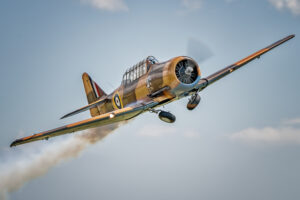 We slow to a crawl and I gently dab the brakes to bring us to a stop, requesting backtrack with an audible smile in my voice betraying the massive grin on my face, which is coupled with a huge surge of relief – I’ve managed to land a Harvard! It wasn’t exactly a greaser, but it was safe, I felt in control, and happily didn’t break anything! At the end of the next circuit, I come in at the right speed and, aware of the fact I flared too late last time, start to apply the flare while higher up. I reach the three-point landing attitude and hold it for what starts to feel like slightly too long a time. Sure enough, we sink the last few inches to the ground a little quickly and make fairly positive contact with the grass. …So, I think, that’s what it feels like to stall it on! I nonetheless remember to control the Wabbit on the ground, and backtrack once more for what I hope will be a landing somewhere roughly in the middle of my last two attempts. In fact, the next three landings do turn out to be somewhere in-between, though I notice I do have a tendency to flare slightly late. Trying to be patient with myself and remember I’m sat higher up than ever have been in a piston aircraft, with a vantage point over 8 feet off the ground, I tell myself I just need to get my eye in and, miraculously, on the last attempt before a coffee break, she seems to land perfectly; all three wheels touching down gently just as the three point attitude is set. Andy gives a little cheer from the back and we head in for a brew, a debrief, and a well-earned slice of cake!
We slow to a crawl and I gently dab the brakes to bring us to a stop, requesting backtrack with an audible smile in my voice betraying the massive grin on my face, which is coupled with a huge surge of relief – I’ve managed to land a Harvard! It wasn’t exactly a greaser, but it was safe, I felt in control, and happily didn’t break anything! At the end of the next circuit, I come in at the right speed and, aware of the fact I flared too late last time, start to apply the flare while higher up. I reach the three-point landing attitude and hold it for what starts to feel like slightly too long a time. Sure enough, we sink the last few inches to the ground a little quickly and make fairly positive contact with the grass. …So, I think, that’s what it feels like to stall it on! I nonetheless remember to control the Wabbit on the ground, and backtrack once more for what I hope will be a landing somewhere roughly in the middle of my last two attempts. In fact, the next three landings do turn out to be somewhere in-between, though I notice I do have a tendency to flare slightly late. Trying to be patient with myself and remember I’m sat higher up than ever have been in a piston aircraft, with a vantage point over 8 feet off the ground, I tell myself I just need to get my eye in and, miraculously, on the last attempt before a coffee break, she seems to land perfectly; all three wheels touching down gently just as the three point attitude is set. Andy gives a little cheer from the back and we head in for a brew, a debrief, and a well-earned slice of cake!
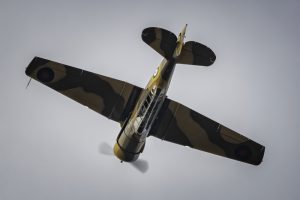 The next steps are to continue perfecting the three-pointers, try some wheelers and crosswind landings, and practice emergencies. T6 Harvard have been an incredibly welcoming and friendly bunch, all very keen to share their experiences and to help other pilots get a taste of what it’s like to fly such an important piece of our aviation heritage. They have also noticed how few women there are flying warbirds and vintage aircraft in general, and are keen to show that there’s no reason why that should be the case! I recommend any pilot, whatever their gender, who is looking to immerse themselves in some of their history, and to give themselves a really rewarding challenge, to get in touch with the T6 Harvard team and book a trial lesson. Alternatively, if you’ve got any loved ones who might want a go in the backseat of a flying piece of our history, or just a truly white-knuckle ride, an aerobatic sortie in the Wacky Wabbit would make a great gift! Head to www.T6Harvard.com for more!
The next steps are to continue perfecting the three-pointers, try some wheelers and crosswind landings, and practice emergencies. T6 Harvard have been an incredibly welcoming and friendly bunch, all very keen to share their experiences and to help other pilots get a taste of what it’s like to fly such an important piece of our aviation heritage. They have also noticed how few women there are flying warbirds and vintage aircraft in general, and are keen to show that there’s no reason why that should be the case! I recommend any pilot, whatever their gender, who is looking to immerse themselves in some of their history, and to give themselves a really rewarding challenge, to get in touch with the T6 Harvard team and book a trial lesson. Alternatively, if you’ve got any loved ones who might want a go in the backseat of a flying piece of our history, or just a truly white-knuckle ride, an aerobatic sortie in the Wacky Wabbit would make a great gift! Head to www.T6Harvard.com for more!